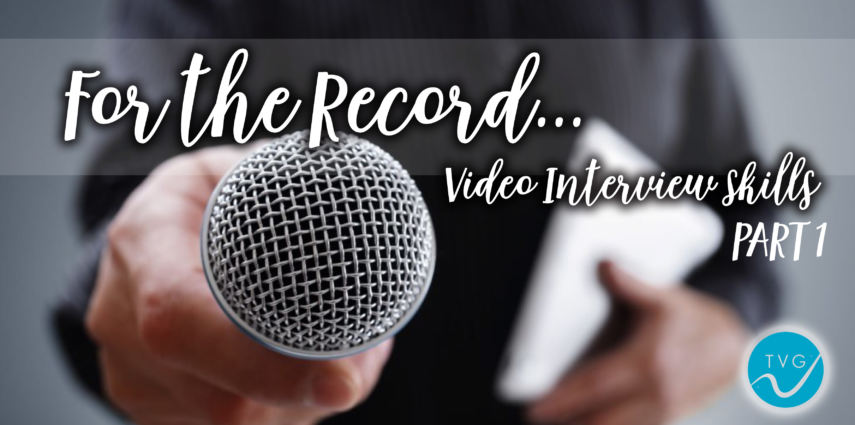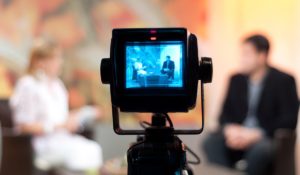The Video Interview Part One: You, the Interviewer
by Rich McEwen, TVG Media Specialist
Whether you’re interviewing a Fortune 500 CEO or a local spelling bee champion, good interviewing skills are vital. A clear and concise story is the goal for both the interviewer and interviewee. In part one I will share some of my experience and techniques that you can use as an interviewer to get the most from your time. In Part Two, I’ll share some ways that will help you be a better interviewee. This will include tips on how to communicate your key messages.
Before the Interview.
At least a couple of days in advance of the interview, send your subject the topics to be covered and the specific questions you will ask. Giving them specific questions may allow them try to memorize their answers (which you don’t want), but I generally will do it anyway to make sure they know what they need be prepared for. This is also the time to confirm the date, time and location, give them tips on what they should wear (coat and tie versus casual, for instance), and explain how the video will be used (online, social media, presentations, etc.).
Release Form.
Before you get started, have the subject sign a release form. You can find samples online. I have personally never had to use one in a dispute, but you will sleep better if you have it.
Before You Start.
Give your subject a summary of what you will be covering. Explain to your subject that you may be asking some questions more than once, in order to have editing options. Make sure they know where to look (at you and not into the camera).
The Slate.
At the start of the interview I generally ask the subject to “slate” the video by stating their name, how to spell it, and their title. I also ask for the subject’s business card as a backup.
Telling the Story.
If your program will not have a narrator, be sure that the information you get from the interview(s) will cover the complete story and hit all the key message points. Even if you will be using a narrator, it’s a good idea to do this. It will give you some scripting and editing options.
Keep it Short.
You want your subject’s answers to be concise and to the point. This may require asking the same question in different ways, which will give your editor more options.
Edit in Your Head.
If I had to pick the most important thing about doing interviews, it would be: Listen. As I conduct the interview, I keep track of what the person is saying and do rough editing in my head. I’ll ask myself if what they are saying makes sense in context and if it can be cut together with other clips to tell the overall story. I also make sure there are no stumbles or audio problems. If they say, “As I said before…” or reference an earlier answer, you may want to have them give the answer again.
Context.
Make sure your interview subject provides context. For instance, they should say: “The XXX Company was founded” rather than “We were founded…”
Follow Up.
Interviews should be dynamic and flexible. If the subject says something that gives you an idea for more questions, ask them, even if they aren’t on your question list.
Being both interviewer and camera operator isn’t easy, but it is possible with planning.
Multi-Tasking.
If you are running camera as well as being the interviewer (not something I recommend – multitasking often makes you worse at both tasks), place an object in the direction you want your subject to look. It can be anything from a piece of gaff tape to a flower vase. Telling someone to talk to a flower vase may seem odd, but it works.
Visual Variety.
If you are doing multiple interviews, have some subjects face camera left and others camera right, so they aren’t all looking the same way when the clips are edited together. If you get your basic answers in a medium shot, and want to get some backup answers, zoom in some to give the program a little visual variety. I generally will also get closer if I know the subject is going to say something important or emotional. It makes a bigger impact.
Speaking of Emotion.
In many applications, how the subject feels about an issue is at as important as how they think about it. So, ask “How do you feel about this?” rather than “What do you think about this?” Don’t go overboard on this. It can be exploitative if not done carefully.
Microphone.
I don’t think it’s usually necessary to hide a lapel microphone, but some may want to do it for aesthetic reasons. This may increase the chance you’ll get some rustle on the mic if it rubs against the person’s clothing when they move.
Be Supportive.
If they’re doing a good job, tell them. Let them know when you have what you need (when you do), even if you want to ask a few more questions. It may calm them a bit.
Anything I Didn’t Ask?
Ask your subject if there is something important that you didn’t ask. Most people will say no but every so often you will be surprised and get some insight that you didn’t expect.
And of course, thank them when you’re done. But you knew that already.
Please note: these tips are primarily for generally informational/corporate video programs. If you’re doing an interview for the press, some of these considerations apply but media training is necessary, particularly in contentious situations.


